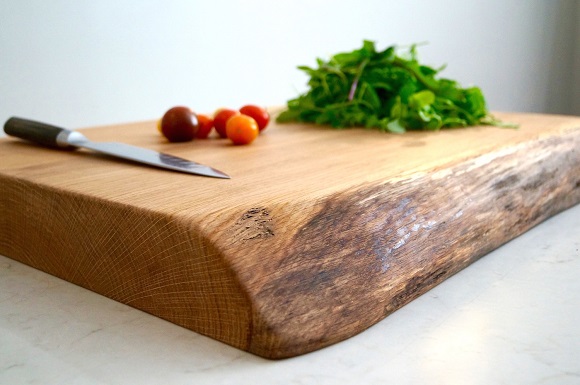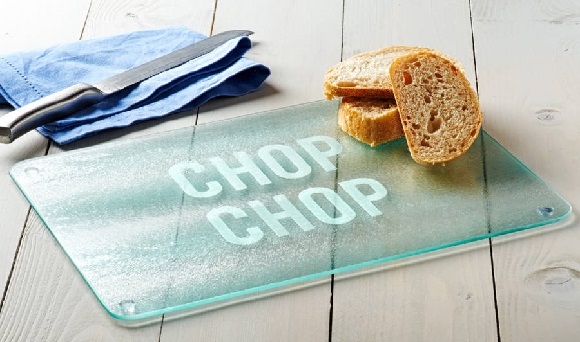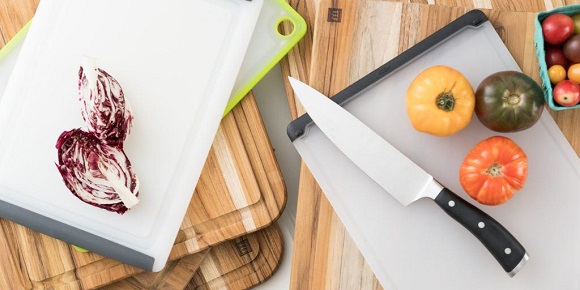When it comes to kitchen accessories, most people worry about choosing the right appliances. What food processor to buy? Is a halogen oven a safe choice? – These are some of the most common questions when equipping a kitchen. What kind of chopping board to buy is something one rarely considers. You just walk into a store and pick the first one you see, right?
Well, although chopping boards are simple and affordable kitchen accessories, taking your time to research the available options can prove to be significant for your health. After all, the food you eat will come into direct contact with the chopping board. Cutting boards can be made from a variety of materials, but wood, glass and plastic are the ones you’ll likely come across when shopping for a new board. With that being said, here’s an overview on which material is best for particular foods, which is easier to clean and which shouldn’t be used at all.
Wooden Boards

Wooden boards were the only chopping boards to be used for thousands of years. However, today many people believe wooden boards aren’t a safe option due to having a porous surface where food residue can get stuck and lead to bacteria growth. Due to this, plastic boards are often falsely considered to be a more hygienic choice. However, plastic boards are susceptible to cuts from being used, where bacteria can enter.
But although most wooden boards are indeed porous, there are some that have been recognized for their unique anti-bacterial properties. Tests conducted by Alan Waterson, from Southern Cross University, proved that Camphor Laurel chopping boards are the most hygienic when compared with plastic, glass and even other timbers. The following are the extract results of the study.
|
|
Mean Number of Organisms per Board |
|||
|
Type of Organism |
Camphor Laurel |
Cedar |
Plastic |
Glass |
|
Fungi |
3.3 |
8 |
9.7 |
5.7 |
|
Bacteria |
0.7 |
1.7 |
7.3 |
8 |
|
Total |
4 |
9.7 |
17 |
13.7 |
The reason Camphor Laurel is a material that is very resistant to the build-up of germs is the fact that it contains several natural anti-microbial chemicals such as camphor, safrole, cineole and limonene. Although these substances can kill off certain types of bacteria, they are safe for people, as they occur naturally in some edible plants such as cinnamon, coriander, sage, rosemary and similar herbs. Considering this, if you want the beauty of a traditional wooden chopping board, picking on made of Camphor Laurel may be the best choice you can make.
Plastic Boards
The popular theory that favours plastic boards is that wooden surfaces are porous and allow for bacterial absorption. However, this theory doesn’t consider the fact that our sharp knives create cuts and groves into the plastic where bacteria can hang out. In addition, these cuts allow for tiny particles of plastic to get into our food every time we use the board. What’s more, like all plastic items, plastic boards also take hundreds of years to degrade once disposed of, and as such have a bad rep for polluting the environment. When you consider this, the plastic board doesn’t look so great, does it?
But opposed to wooden and glass cutting boards, plastic ones are a lot more affordable. And perhaps the biggest advantage of plastic chopping boards is that they can be easily disinfected, either by hand or with the help of a dishwasher. On the other hand, wooden chopping boards are not dishwasher-safe.
Glass Boards

Glass cutting boards are some of the easiest kitchen accessories to clean due to their smooth surface. They can be washed by hand or placed in the dishwasher. Since they’re non-stick, glass boards are best for kneading dough or cutting out cookies. They are also very hard to get scratched and damaged by knife use. But the hard surface can dull your knives over time. In addition, glass boards can also be very loud. Every time you chop something using the board, there’s going to be an echo throughout your kitchen.
Final Thoughts
All things considered, any board can contaminate your food unless you care for it properly and replace it when its time comes. Whatever type of board you choose, it’s important to replace it once it becomes excessively worn out and has developed deep grooves that are hard to clean. Be always sure to wash and dry the board well after each use. You can try lightly rubbing it with mineral oil to prevent moisture and bacteria from seeping in.
Ultimately, the best thing you can do to avoid getting your food contaminated is to use different boards for different foods. For instance, have a separate cutting board for meat and poultry and a separate one for vegetables, fruit and other raw food. In general, using separate kitchen accessories for different foods is one of the best ways to prevent cross-contamination, which is one of the most common causes of food poisoning.

